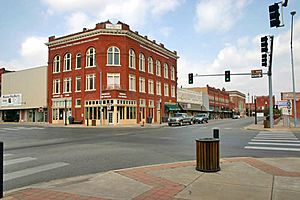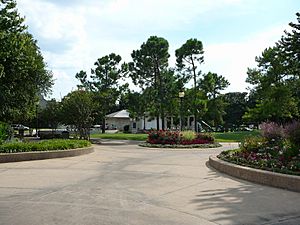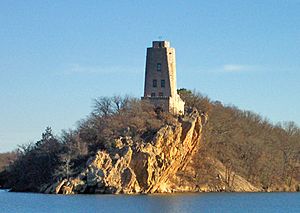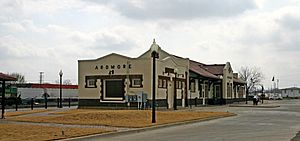Ardmore, Oklahoma facts for kids
Quick facts for kids
Ardmore, Oklahoma
|
||
|---|---|---|
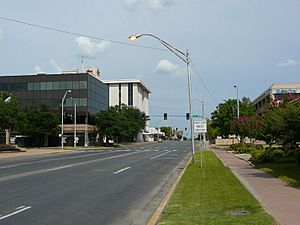 |
||
|
||

Location in the state of Oklahoma
|
||
| Country | United States | |
| State | Oklahoma | |
| County | Carter | |
| Area | ||
| • Total | 51.76 sq mi (134.06 km2) | |
| • Land | 49.83 sq mi (129.06 km2) | |
| • Water | 1.93 sq mi (5.00 km2) | |
| Elevation | 879 ft (268 m) | |
| Population
(2020)
|
||
| • Total | 24,725 | |
| • Density | 496.20/sq mi (191.58/km2) | |
| Time zone | UTC−6 (CST) | |
| • Summer (DST) | UTC−6 (CDT) | |
| ZIP codes |
73401-73403
|
|
| Area code(s) | 580 | |
| FIPS code | 40-02600 | |
| GNIS feature ID | 2409727 | |
Ardmore is a city in Oklahoma, United States. It is the main city of Carter County. In 2020, about 24,725 people lived there.
Ardmore is located about 90 miles (145 km) from both Oklahoma City and Dallas/Fort Worth, Texas. It sits where two major roads, Interstate 35 and U.S. Highway 70, meet. This makes Ardmore an important center for the southern part of Oklahoma. This area is also known as "Chickasaw Country" for tourism.
The city's name, "Ardmore," comes from a town in Pennsylvania. That town was named after a place in Ireland. In Irish, "Ardmore" means "high grounds" or "hill."
Contents
History of Ardmore
Ardmore started in the summer of 1887. It grew because the Santa Fe Railroad was built through the area. At first, it was a trading post for the region.
In 1895, a big fire destroyed much of the town. Residents had to rebuild almost everything. In the early 1900s, Ardmore became famous for its large cotton fields. It was even known as the world's biggest inland cotton port.
Oil and Growth
Ardmore is near the Healdton Oil Field, which was discovered in 1913. Many people came to the area, and Carter County quickly became the top oil-producing county in Oklahoma. Ardmore has been an energy hub ever since.
On September 27, 1915, a train car carrying gas exploded. This tragic event killed 43 people and destroyed much of downtown. After this, the city decided to create its first fire department to prevent similar disasters.
Sports in Ardmore
Ardmore has a history with minor league baseball. Teams from Ardmore played in different leagues over the years. They won championships in 1923, 1925, and 1957.
A famous baseball player, Carl Hubbell, played for the Ardmore Bearcats in 1924. He later became a member of the Baseball Hall of Fame.
Geography and Nature
Ardmore is in southeastern Carter County. It is about 97 miles (156 km) north of Oklahoma City and 103 miles (166 km) south of Fort Worth, Texas.
The city covers about 51.8 square miles (134.1 square kilometers). Most of this area is land, with a small part being water.
Ardmore is located about 10 miles (16 km) south of the Arbuckle Mountains. These are old, worn-down mountains that stretch for about 62 miles (100 km) across southern Oklahoma. The area around Ardmore has many different types of rocks and landforms.
The city itself does not have any major rivers. However, it is part of the Washita and Red River systems. Ardmore is also about 3 miles (5 km) north of Lake Murray. This lake is a popular spot for outdoor activities.
Climate in Ardmore
Ardmore has a climate with warm summers and mild winters. The hottest month is usually August, and the coldest is January. The city gets a good amount of rain throughout the year.
People of Ardmore
| Historical population | |||
|---|---|---|---|
| Census | Pop. | %± | |
| 1900 | 5,681 | — | |
| 1910 | 8,618 | 51.7% | |
| 1920 | 14,181 | 64.6% | |
| 1930 | 15,741 | 11.0% | |
| 1940 | 16,886 | 7.3% | |
| 1950 | 17,890 | 5.9% | |
| 1960 | 20,184 | 12.8% | |
| 1970 | 20,881 | 3.5% | |
| 1980 | 23,689 | 13.4% | |
| 1990 | 23,079 | −2.6% | |
| 2000 | 23,711 | 2.7% | |
| 2010 | 24,283 | 2.4% | |
| 2020 | 24,725 | 1.8% | |
| Sources: | |||
In 2010, there were 24,283 people living in Ardmore. The city is home to people from many different backgrounds. About 73% of the population was White, 11% African American, and 9% Native American.
The average age in Ardmore was 39 years old. About 25% of the people were under 18.
Economy and Jobs
Ardmore is a major center for trade in its region. Many people from nearby counties come to Ardmore to shop.
Some of the biggest employers in Ardmore include:
- Michelin North America: A large tire company. The tire building part of the plant is closing in 2025.
- Mercy Hospital Ardmore: A hospital that employs many people.
- Distribution centers for companies like Best Buy and Dollar Tree.
Ardmore also has a Valero oil refinery. This refinery processes a lot of oil each day. The Samuel Roberts Noble Foundation is also in Ardmore. It is a large organization that does research in agriculture.
In 2001, East Jordan Iron Works opened a factory in Ardmore. In 2020, the Oklahoma Blood Institute opened a large blood donation center here.
Arts and Fun
Ardmore has several places for entertainment and events:
- Ardmore Civic Auditorium: A historic building that hosts concerts and local events.
- Hardy Murphy Coliseum: A historic facility built during the WPA era. It hosts rodeos and other regional events.
The movies Dillinger (1973) and Fast Charlie... the Moonbeam Rider (1979) were partly filmed in Ardmore.
Education in Ardmore
Colleges and Universities
Ardmore is home to the University Center of Southern Oklahoma. This center allows students to take classes and earn degrees from several different universities. These include Murray State College, Southeastern Oklahoma State University, East Central University, and Oklahoma State University.
Schools for Kids
Public schools in Ardmore are run by Ardmore City Schools and Plainview Public Schools. There is also the Ardmore Christian School.
Ardmore-Oak Hall Episcopal School is one of only three Episcopal schools in Oklahoma.
The CareerTech also has a campus in Ardmore. It offers training for different jobs.
Media and News
Newspaper
- The Daily Ardmoreite: Ardmore's local newspaper, published since 1893.
Television Channels
- KTEN – Channel 10 (NBC)
- KXII – Channel 12 (CBS)
- K36KE-D – Channel 36 (PBS OETA)
Radio Stations
- KVSO – 1240 AM (news/talk)
- KFXI – 92.1 FM (Country music)
- KTRX – 92.7 FM (Classic Rock music)
- KKAJ – 95.7 FM (Country music)
- KICM – 97.7 FM (Country music)
- KYNZ – 107.1 FM (Oldies music)
Getting Around Ardmore
Highways
Interstate 35 runs through the western side of Ardmore. This highway goes all the way from Minnesota to Texas.
Ardmore has several exits off I-35, connecting to other important roads like US-70 and State Highway 199.
Airports
Ardmore has two airports for general aviation: Ardmore Downtown Executive Airport and Ardmore Municipal Airport. For scheduled flights, the closest major airports are in Oklahoma City and Dallas/Fort Worth.
Train Travel
Ardmore has a main train line run by Burlington Northern Santa Fe. This line connects Fort Worth, Texas, to Oklahoma City. The Heartland Flyer passenger train uses this route, offering daily service.
The historic Santa Fe depot in downtown Ardmore is a stop for Amtrak's Heartland Flyer train.
Local Transportation
Ardmore also has a scheduled stop for Greyhound and Jefferson Bus Lines.
The Southern Oklahoma Rural Transportation System (SORTS) provides local bus services. It helps people get to work, medical appointments, and other places in the area.
Years ago, Ardmore even had streetcars! They ran from 1906 until 1922.
Historic Places
Ardmore has many buildings and sites listed on the National Register of Historic Places. Some of these include:
- Ardmore Carnegie Library
- Ardmore Municipal Auditorium
- Black Theater of Ardmore
- Carter County Courthouse
- Central Park Bandstand
- Hardy Murphy Coliseum
- Lake Murray State Park
- Oklahoma, New Mexico and Pacific Railroad Depot
Famous People from Ardmore
Many notable people have connections to Ardmore:
- Thomas Benson: A football player for the Los Angeles Raiders.
- Justin Blackmon: A former football wide receiver.
- Charles Coe: A two-time U.S. Amateur golf champion.
- Eric Fields: A professional boxer.
- Mark Gastineau: A former NFL defensive star for the New York Jets.
- Sylvan Goldman: The inventor of the shopping cart.
- Jermaine Gresham: A former football tight end for the Cincinnati Bengals and Arizona Cardinals.
- Columbus Marion Joiner: Known as the "father" of the East Texas Oil Field.
- Terence C. Kern: A United States District Judge.
- Rue McClanahan: An Emmy Award-winning actress, known for The Golden Girls.
- Mazola McKerson: The first African American mayor of Ardmore and the first female mayor of a city over 30,000 in the US.
- Joe McQueen: A jazz musician.
- Tessie Mobley: An operatic soprano.
- Samuel Lloyd Noble: An oilman and philanthropist, who founded Noble Corporation.
- Mike Pouncey: A football center for the Miami Dolphins.
- Rex Ryan: An NFL head coach.
- Russ Saunders: A former football fullback for the Green Bay Packers.
- Michael Schwab (designer): An American graphic designer and illustrator.
- Mauree Turner: An Oklahoma politician.
See also
 In Spanish: Ardmore (Oklahoma) para niños
In Spanish: Ardmore (Oklahoma) para niños



